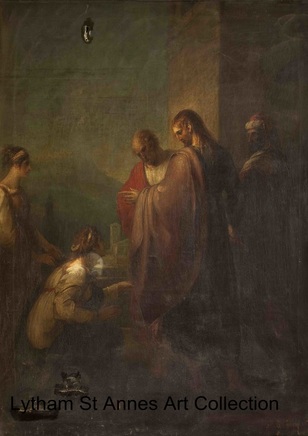Christ and Mary Magdalene
|
Research by Jennifer Taylor
|
|
PAINTING
This large oil painting shows Mary Magdalene kneeling at the feet of Christ, holding the edge of his robe to attract his attention and appealing to him. The figures on the right almost look surprised by her actions, as if she has disturbed them, and the female standing on the left holds out her hands, either to support or possibly to attempt to hold her back. The light on the picture is focused upon the face of Christ, his hand outstretched, and follows his gaze down to Mary. In the background a stylistic town can be seen before the fading hillside but unfortunately the foreground is obscured and has what looks like some damage to the canvas, perhaps due to a poor attempt at cleaning. Mary Magdalene anointed the feet of Christ following the crucifixion and was the first person to see him after the resurrection. She was made a saint and is often depicted holding a jar of oil. ARTIST The painting was originally attributed, in 2001, to George Hamilton Constantine (1878-1967) but amended by Christies in 2012 as being the work of an earlier artist, Richard Westall (1765-1836). Constantine has a wide catalogue of landscape paintings of scenes in Lancashire, Yorkshire and Cornwall, frequently featuring horses. He painted in a very different style to this piece. He has no other major works which cover either religious subjects or people as the main focus. On the other hand, Richard Westall painted portraits and historical scenes, some of which show a similar background effect to that in our picture and there are also similarities in the features of his figures when compared, for example, to the large oil painting of The Reconciliation of Helen and Paris After his Defeat by Menelaus (1895), shown below, although this picture is far more detailed and ‘polished’. |
REFERENCES
(Accessed October 2014) (Accessed October 2014) |
Richard Westall was born in Hertford but came from a Norwich family. Initially becoming an apprentice to a silver engraver, he was advised to take up painting by the miniaturist, John Alefounder (1757-1794). He went on to exhibit at the Royal Academy in 1784 and the British Institution, mainly in watercolour, where he was described as using ‘violent and excessive colours’ as well as a more ‘Rococo prettiness’ in his figures, and as such he was reported as a leader in the reform of figure painting in watercolour at the time.
Westall also produced a number of large works in oil, but when these failed to sell he turned to book illustrating as his main source of income. His prolific output included the works of Sir Walter Scott, Oliver Goldsmith, William Cowper and Thomas Gray. Byron, who greatly admired his work, stated that 'the brush has beat the poetry'. Westall was also commissioned to provide illustrations to John Boydell's editions of Shakespeare and the works of John Milton.
In addition, he provided a number of illustrations on religious themes, such as John Hobart Caunter’s Illustrations of the Bible in 1835 and twelve paintings of the Rites and Ceremonies of the Church of England. These were also engraved and became very popular, showing his work in a positive light. His oil painting, Christ Crowned with Thorns, is the altarpiece at All Souls Church, Langham Place, London.
Unfortunately, in later life he lost most of his money by poor art dealing and other bad speculations, leaving him in poverty and reliant on relief from the Royal Academy. His last known occupation was as an 'instructor in painting and drawing to the Princess Victoria', later Queen Victoria, which he carried out for the eight years prior to his death on 4 December 1836.
Richard Westall is perhaps best known for several portraits of Lord Byron. One of these hangs in the National Portrait Gallery in London, another at Hughenden Manor and a third in the House of Lords.
Westall also produced a number of large works in oil, but when these failed to sell he turned to book illustrating as his main source of income. His prolific output included the works of Sir Walter Scott, Oliver Goldsmith, William Cowper and Thomas Gray. Byron, who greatly admired his work, stated that 'the brush has beat the poetry'. Westall was also commissioned to provide illustrations to John Boydell's editions of Shakespeare and the works of John Milton.
In addition, he provided a number of illustrations on religious themes, such as John Hobart Caunter’s Illustrations of the Bible in 1835 and twelve paintings of the Rites and Ceremonies of the Church of England. These were also engraved and became very popular, showing his work in a positive light. His oil painting, Christ Crowned with Thorns, is the altarpiece at All Souls Church, Langham Place, London.
Unfortunately, in later life he lost most of his money by poor art dealing and other bad speculations, leaving him in poverty and reliant on relief from the Royal Academy. His last known occupation was as an 'instructor in painting and drawing to the Princess Victoria', later Queen Victoria, which he carried out for the eight years prior to his death on 4 December 1836.
Richard Westall is perhaps best known for several portraits of Lord Byron. One of these hangs in the National Portrait Gallery in London, another at Hughenden Manor and a third in the House of Lords.


